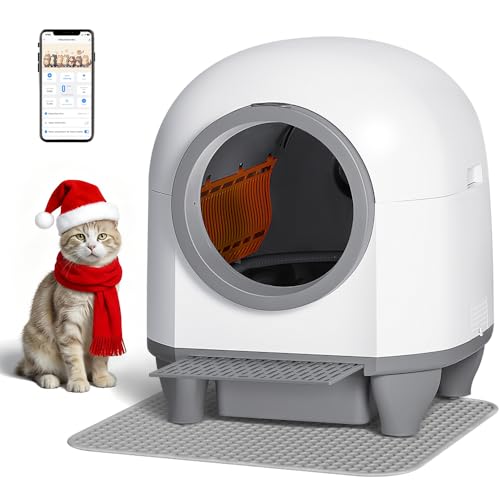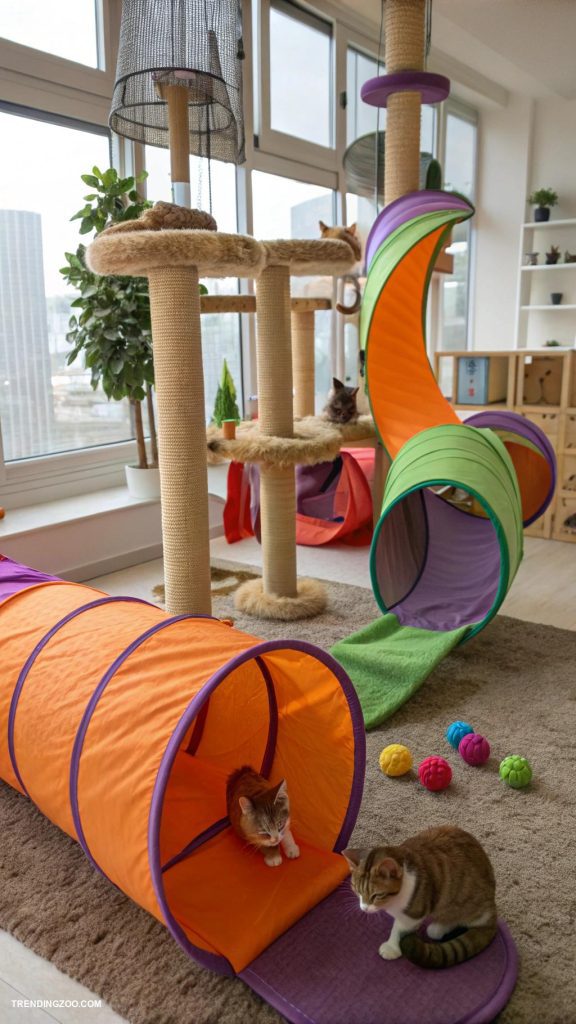Finding the purr-fect spot for your cat’s litter box can be a daunting task, especially when you’re trying to balance your own comfort and style with your pet’s needs. It’s a common conundrum that many cat owners face – where to place the litter box to ensure your feline friend stays happy and healthy, while also keeping the rest of the household odor-free and aesthetically pleasing.
In this article, we’ll explore the dos and don’ts of placing the litter box in your home, from the best locations to avoid to clever hacks for minimizing odors and messes. Whether you’re a seasoned cat owner or a newcomer to the world of feline companions, you’ll learn how to strike the perfect balance between cat and human comfort in your home.
Understanding Your Cat’s Behavior and Preferences
When it comes to understanding your cat’s behavior and preferences, it’s essential to consider their natural instincts and habits. Cats are meticulous creatures, and they have a strong sense of smell and cleanliness. They prefer to use a litter box that is clean, quiet, and private. In the wild, cats typically bury their waste to conceal their scent from predators and competitors. This instinctual behavior translates to their litter box habits, where they prefer to cover their waste with litter.
For this reason, it’s crucial to scoop the litter box daily and change the litter completely every 7-10 days. Additionally, cats often prefer a litter box with low sides and a non-slip surface, making it easier for them to enter and exit.
Some cats may also have specific preferences for litter texture, odor, and type, so it’s a good idea to observe your cat’s behavior and adjust the litter accordingly. By understanding your cat’s unique preferences and habits, you can create a comfortable and welcoming environment that meets their needs and promotes good litter box etiquette.
Ideal Locations for the Litter Box
When it comes to selecting the ideal location for your cat’s litter box, there are several factors to consider. One important consideration is the amount of foot traffic in the area. Cats are naturally territorial and prefer to keep their litter box out of the way of high-traffic zones, as they can be sensitive to noise and commotion. A quiet, low-traffic area is ideal, such as a laundry room or a dedicated pet area.
Additionally, it’s essential to choose a location that is easily accessible for your cat, but not so close to their food and water bowls that they associate the litter box with eating. A general rule of thumb is to place the litter box at least three to four feet away from their food and water stations. In terms of specific rooms, the litter box can be placed in a bathroom, bedroom, or even a dedicated cat room, as long as it is not in a high-traffic area or near the kitchen.
It’s also important to consider the size of the litter box and the space available in the chosen location. A larger litter box may require a more spacious area, while a smaller litter box can fit in a smaller space. Ultimately, the key is to find a location that is quiet, accessible, and discreet, allowing your cat
Factors to Consider: Privacy, Accessibility, and Odor Control
When deciding where to place the cat litter box in your home, it’s essential to consider several factors to ensure a harmonious and healthy environment for both you and your feline friend. One crucial aspect to consider is privacy. Cats are naturally inclined to do their business in private, so it’s vital to place the litter box in a location where your cat can feel safe and undisturbed. This could be a quiet corner of a room, a closet, or even a designated area behind a screen or curtain.
Avoid placing the litter box in high-traffic areas or directly next to your cat’s food and water bowls, as this can create an unpleasant atmosphere and potentially attract pests.
Accessibility is another vital factor to consider when selecting a location for your cat’s litter box. Cats prefer to have easy access to their litter box at all times, so it’s essential to place it in a location that allows your cat to come and go as they please.
Avoid placing the litter box in areas that are difficult for your cat to reach, such as high shelves or hard-to-reach corners. Additionally, consider the size of your cat and the litter box itself, ensuring that the litter box is large enough for your cat to comfortably turn around and move about. Finally, odor control is
Common Mistakes to Avoid When Placing the Litter Box
When it comes to placing the litter box in your home, it’s essential to avoid common mistakes that can lead to undesirable outcomes. One of the most critical errors is placing the litter box in a high-traffic area, such as the middle of the living room or near the front door. This can lead to unpleasant odors and messes being tracked throughout the house.
Additionally, placing the litter box in a location where your cat can’t easily access it, such as a closet or behind a door, can cause frustration and accidents. It’s also important to avoid placing the litter box near your cat’s food and water bowls, as this can create an unpleasant association with eating and drinking.
Furthermore, placing the litter box in a location with poor ventilation can exacerbate odors and create an unpleasant environment for both you and your cat.
Finally, consider the noise level of the area, as a loud or busy space can be stressful for your cat and make the litter box experience unpleasant. By avoiding these common mistakes, you can create a comfortable and convenient space for your cat to use the litter box.
The Role of Multiple Litter Boxes in Multi-Cat Households
In multi-cat households, the presence of multiple litter boxes is crucial for maintaining a clean and healthy environment for your feline friends. When multiple cats share a single litter box, it can lead to territorial disputes, health issues, and unpleasant odors. A general rule of thumb is to provide one litter box per cat, plus one extra.
For example, if you have three cats, you should have at least four litter boxes. This ensures that each cat has its own designated area to do their business without feeling crowded or competing with others. Placing multiple litter boxes in different areas of the home can also help to reduce stress and conflict among cats.
Cats are naturally territorial, and having separate litter boxes can help to minimize competition and territorial marking. It’s also important to consider the location of each litter box in relation to the number of cats using it.
For example, if you have a litter box in a high-traffic area, you may want to place an additional litter box in a quieter area to provide an alternative option for cats who prefer a more secluded spot.
In addition to reducing conflict and stress, multiple litter boxes can also help to improve odor control and cleanliness. When cats have their own litter boxes, they are less likely to mark their territory outside of the box or
Alternatives to Traditional Litter Box Locations
When it comes to choosing the perfect location for your cat’s litter box, many pet owners opt for the traditional spot – a quiet corner in the bathroom or a hidden area behind a door. However, this may not be the most effective or hygienic solution for your feline friend.
Petmate Litter Pan, Blue/Gray, Small, Made in USA
50% OffConsider alternatives to the traditional litter box location, such as a dedicated cat room or a designated area in a mudroom or laundry room. These spaces can provide a more private and quiet environment for your cat to do its business, away from high-traffic areas and potential distractions.
Additionally, you can also consider placing the litter box in a location with easy access to ventilation, such as near a window or a door leading outside, to help reduce odors and unpleasant smells. If you’re short on space, consider a multi-functional litter box that doubles as a storage unit or a stylish decorative piece, allowing you to keep the litter box out of sight while still providing your cat with a comfortable and convenient place to use.
Tips for Maintaining a Clean and Inviting Litter Box Area
When it comes to maintaining a clean and inviting litter box area, there are several key tips to keep in mind. First and foremost, it’s essential to scoop the litter box daily to remove any solid waste and clumps. This not only helps to reduce odors but also prevents bacteria from growing and spreading diseases.
Additionally, it’s a good idea to change the litter completely every 7-10 days to prevent buildup and keep the area fresh. Another important consideration is the location of the litter box itself. Ideally, it should be placed in a quiet, low-traffic area where your cat can easily access it without feeling exposed or vulnerable.
Dr. Elsey's Ultra UnScented Clumping Clay Cat Litter 40 lb. Bag
$22.99 ($0.04 / fluid ounce) (as of December 7, 2025 03:25 GMT -05:00 - More infoProduct prices and availability are accurate as of the date/time indicated and are subject to change. Any price and availability information displayed on Amazon at the time of purchase will apply to the purchase of this product.)Avoid placing it near your cat’s food and water bowls, as this can create unpleasant associations and make your cat less likely to use the litter box. Finally, consider adding a litter box liner or mat to make cleanup easier and help contain any spills or messes.
By following these simple tips, you can create a clean and inviting litter box area that your cat will appreciate and use consistently!














